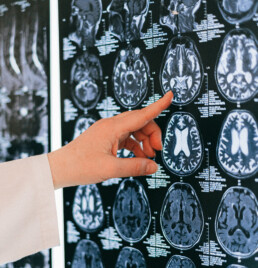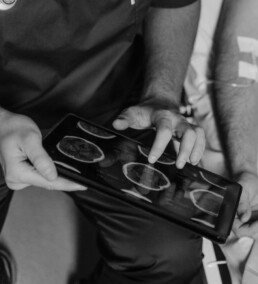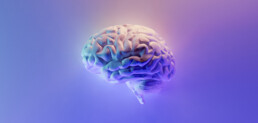Impairments in the temporal organization of neural activity in patients with neuropathic pain
Treating neuropathic pain, often characterized by intense shooting, stabbing, or burning pain, is a major healthcare challenge. It is thought that the dynamic organization of neural networks is affected in patients with chronic pain.
Written by:
Quinn Pauli
Edited by:
Georgia Hadjis
Electrical activity may be used as a potential diagnostic and therapeutic to target these affected networks, referred to as ‘brain microstates’. Electrical activity can be measured using magnetoencephalography (MEG), a sensitive imaging tool with high temporal resolution that can identify neuronal oscillations in the alpha frequency band, which is thought to be a potential neuromarker of abnormal brain activity in chronic pain.In the present study, UTCSP members Dr. Camille Fauchon and Dr. Andrew Kim, along with Dr. Karen Davis, Dr. Anuj Bhatia and colleagues applied a Hidden Markov Model (HMM) statistical approach. to MEG data to divide cortical activity on the scalp surface into organized brain states to identify activity changes that accompany neuropathic pain.
Abnormalities in neural oscillations can be an indication of pathology, and by uniquely combining an HMM approach to MEG, the authors were able to estimate when certain brain networks are active, and thus determine the impact of pain on neural activity. Forty patients with chronic neuropathic pain were compared to 40 age- and sex-matched healthy controls, where twelve cognitive brain states in the dynamic pain connectome were identified for each patient at rest. Distinct abnormalities in temporal neural activity were observed in the neuropathic pain group, indicating impaired coordination and engagement of network activity over time. Specifically, patients spent more time in the sensorimotor state and less time in the dorsal attention state compared to healthy controls. Patients also demonstrated greater alpha power in the state representing the ascending nociceptive pathway. Together, these results suggest abnormal pain regulation in patients with neuropathic pain.

The main findings this study, published in Communications Biology, point to a potential impairment in neuronal communication between brain areas involved in nociceptive processing and pain suppression in people living with chronic neuropathic pain. This study showed for the first time that the HMM approach applied to MEG data can capture brain microstates underlying pain, while identifying correlational brain state markers for neuropathic pain conditions. Ultimately, exploring the dynamics of brain activity in chronic pain populations may lead to novel diagnostic and therapeutic approaches in the clinic.
Brain-age gaps as a biomarker for pain treatment in certain pain conditions
Chronic pain can impact many different parts of the body, leading to serious structural and functional effects on the nervous system. Chronic pain and its burden on the brain becomes more prevalent in older adults. In addition, grey and white matter reorganization in the brain is thought to be accelerated in those with chronic pain.
Written by:
Vaidhehi Veena Sanmugananthan
Edited by:
Georgia Hadjis
Gaussian process regression is an adaptive supervised multivariate statistical learning method found to be predictive of chronical age based on neuroimaging data. Models using this method have been used to determine brain predicted age differences across different diseases. Many of these studies have revealed that accelerated brain aging differences in these conditions vs. healthy controls are associated with increased risk of mortality and reduced cognitive abilities.
Studies have shown that a mixed cohort of people with chronic pain have larger brain-age gaps (brain-AGE), suggesting accelerated aging of the brain in chronic pain. Since chronic pain can differ in etiology, severity, pain frequency and sex-linked prevalence, brain-AGE could potentially differ across chronic pain disorders. In this study, UTCSP scientist Dr. Mojgan Hodaie and colleagues aimed to determine brain-AGE across 3 different chronic pain conditions: trigeminal neuralgia [TN], low back pain [BP] and osteoarthritis [OA]. They also examined sex effects in brain-AGE in these pain disorders and whether they relate to TN pain treatment.
A machine learning model was built using publically available neuroimaging data from a 3 Tesla MRI scanner of 812 healthy controls (HCs) in order to extract brain-AGE from 45 TN, 52 OA and 50 BP participants. They used false discovery rate Welch t-tests to delineate significant differences in brain-AGE between each pain group with HCs. The authors found that TN and OA cohorts have significantly larger brain-AGE, and across all pain groups, brain-AGE was driven by females. Large brain-AGE in the TN group was associated with gamma knife radiosurgery for pain and inversely associated with age of diagnosis of the pain disorder. These results suggest that younger women with TN are a potential vulnerable group that may require more prevalent and earlier chronic pain interventions. Based on these results, the authors concluded that brain-AGE could likely be used as a biomarker for efficacy of pain treatment.
These results suggest that younger women with TN are a potential vulnerable group that may require more prevalent and earlier chronic pain interventions. Based on these results, the authors concluded that brain-AGE could likely be used as a biomarker for efficacy of pain treatment.
Project ECHO Ontario Chronic Pain and Opioid Stewardship: minimizing distances and amplifying evidence-based care
The Project extension for community healthcare outcomes (Project ECHO) is a bidirectional teaching strategy that aims to disseminate knowledge and to increase the implementation of best practice in primary care in remote areas. Ontario has implemented the project since 2014 as the ECHO Ontario Chronic Pain and Opioid Stewardship. This unique educational model offers training via videoconferencing for primary care providers (PCP) to deliver specialised care for chronic pain disorders.
The four pillars of ECHO are (1) videoconferencing, (2) sharing best practices, (3) case-based learning, and (4) continuous outcome monitoring. Program ECHO uses videoconference technology to leverage scarce healthcare resources, minimizing distances between specialty and primary care and enabling clinicians from remote areas to discuss their patients’ cases with an expert interprofessional team. In addition, specialist mentors from the ECHO clinic share best practices with PCP to reduce variation in care and improve patient outcomes. PCP participants frequently evolve to become centers of excellence and start providing specialist care to their geographical area as they learn through interaction with the ECHO clinic. The case-based learning process occurs while the ECHO clinic prepares and shares a summary of the discussed case, summary of all recommendations, and relevant community resources not only with the person who presented the case but also with all the participants, which generalises the learning.
Benefits of participating in ECHO include reduction in patients’ expenses and time spent traveling to urban centers, improvement in quality of care in rural and remote areas, provision of no-cost continuing medical education, opportunities for professional interaction with colleagues, and access to specialists. As the ECHO model evolves, better methods for monitoring outcomes and increased rural access to primary care for ECHO will enhance the reach and efficacy of this program.
Benefits of participating in ECHO include reduction in patients’ expenses and time spent traveling to urban centers, improvement in quality of care in rural and remote areas, provision of no-cost continuing medical education, opportunities for professional interaction with colleagues, and access to specialists. As the ECHO model evolves, better methods for monitoring outcomes and increased rural access to primary care for ECHO will enhance the reach and efficacy of this program.
UTCSP members showcase their pain research at Neuroscience 2019
From October 19 to 23 2019, the Society for Neuroscience hosted their 49th Annual Meeting in Chicago, IL. It was undoubtedly an important and lively event with 27,832 attendees from 75 countries, 13,677 abstract presentations, and 833 sessions.
This platform provided the opportunity for UTCSP scientists and trainees to showcase their exciting research through poster and oral presentations. The three main nanosymposiums on pain this year were: 1) Pain and Itch Behavior, Circuitry, and Novel Techniques, 2) Pain Imaging and Perception, and 3) New Approaches for Pain Assessment and Treatment. UTCSP trainees were among the speakers of these sessions.
UTCSP trainee and postdoctoral fellow Kathy Halievski (Salter lab) gave a talk at the “Pain and Itch Behavior, Circuitry, and Novel Techniques” nanosymposium on exploring the curious interplay between pain, sex, and the gut microbiota. Specifically, the project aim was to determine whether the microbiota affects acute nociception or hypersensitivity following pain injury in an animal model, and potential sex differences between this interaction. While sex differences were present in certain pain assays, overall, antibiotic-mediated gut microbiota depletion did not affect behavioural responses in acute nociception or in injury-induced hypersensitivity. These findings are important to consider as this field develops, since some, but not all types of pain exhibit an interplay with the gut microbiota.
At the “Pain Imaging and Perception” nanosymposium, UTCSP trainees and graduate students Peter Hung and Sarasa Tohyama (Hodaie lab) gave a talk on advanced structural imaging in patients with trigeminal neuralgia. Hung and colleagues created a machine learning model to predict long-term response to radiosurgical treatment for trigeminal neuralgia from pre-treatment cortical thickness measurements. After cross-validation, the machine learning model predicted long-term response with an 76.5% accuracy. Thus, this brain-based model surpassed prior white matter nerve-level models for this clinical population. These findings hold strong clinical translational potential, as they may help guide treatment decision-making in the clinic.
Tohyama and colleagues identified and defined a new subtype of trigeminal neuralgia, which they termed “lesional trigeminal neuralgia”, using a clinical and neuroimaging approach. They found that patients with this condition are clinically indistinguishable from classical trigeminal neuralgia, but have a single, isolated, plaque-like lesion in the brainstem. Importantly, these patients are refractory to surgical treatment. Thus, the study highlights the important clinical implications of distinguishing this group from other known types of trigeminal neuralgia in the clinic. The study also points to the role of novel treatment strategies, such as neuromodulation, for their management.
Overall, Neuroscience 2019 showcased the great breadth and quality of neuroscience research, and in particular, pain research at the international level. UTCSP members were an integral part of this meeting, which fostered exciting connections, collaborations, and valuable ideas.
Children with anxiety recall more pain 1 year post-surgery
When recalling post-operative pain, patients who have a negatively-biased recall of pain (i.e. recalled pain is worse than originally reported pain) are at greater risk for the development of chronic pain. In this study by UTCSP scientists, Joel Katz, Jennifer Stinson, and colleagues sought to identify risk factors that promote negatively-biased recall of post-surgical pain in children.
In this prospective study, the authors followed patients at several timepoints throughout their first year post-surgery and asked whether anxiety pre- and post-surgery in children was correlated with negatively-biased recall of their post-operative pain. Specifically, they assessed 3 forms of anxiety: pain anxiety (anxiety during, or in anticipation of, pain), anxiety sensitivity (sensitivity to the symptoms experienced with anxiety), and pain catastrophizing (helplessness or magnification of pain) and three aspects of their current and recalled pain intensity: pain at rest, pain during movement, and pain unpleasantness.
They found that a patient’s anxiety sensitivity and pain catastrophizing pre-surgery were predictive of negatively-biased pain memory at both 6 and 12 months post-surgery. However, the greatest predictor of negatively-biased memory of pain was catastrophizing pain immediately post-surgery (48-72 hours after), specifically, movement-evoked pain. Notably, this study is the first post-surgery pediatric pain memory study that distinguishes between pain at rest and movement-evoked pain. The authors also found that patients with greater negatively-biased recall of pain reported higher pain intensity at 6 and 12 months post-surgery, suggesting a possibility that current pain intensity can bias pain recall.
In summary, the results of this study identify pain catastrophizing during the acute recovery period (i.e., 48 and 72 hours after surgery) as a significant predictor of negatively-biased pain recall long-term (6 and 12 months after surgery). Thus, implementing therapies to reduce pain catastrophizing in patients during this critical period is important to reduce negatively-biased memory of pain, and in turn, hopefully reduce the risk of chronic pain development.
They found that a patient’s anxiety sensitivity and pain catastrophizing pre-surgery were predictive of negatively-biased pain memory at both 6 and 12 months post-surgery. However, the greatest predictor of negatively-biased memory of pain was catastrophizing pain immediately post-surgery (48-72 hours after), specifically, movement-evoked pain.
The link between pain and memory in the medial temporal lobe
The medial temporal lobe (MTL) is primarily thought to be responsible for memory and cognition. However, several functional neuroimaging studies have shown the involvement of this brain region in both the response to experimental pain in healthy individuals and in patients with chronic pain.
Interestingly, the well-known case of patient H.M., who underwent bilateral MTL resection for epilepsy, had reported an unusually high tolerance for heat pain. These previous findings suggest the involvement of the MTL in nociception and pain modulation, in addition to its well-recognized role in memory.
To further explore the involvement of the MTL in nociceptive processing, researchers at the University of Toronto, led by UTCSP members Lizbeth Ayoub and Dr. Massieh Moayedi, conducted two separate meta-analyses of fMRI studies of pain that indicated MTL engagement, and one original empirical study. The first meta-analysis consisted of studies in healthy individuals undergoing experimental pain and the second consisted of chronic pain patients. The first meta-analysis demonstrated increased activation after a pain-inducing stimulus in the right anterior hippocampus, parahippocampal gyrus, and amygdala compared with each subject’s own, non-painful baseline condition.

The second meta-analysis demonstrated that chronic pain patients demonstrate decreased activation in the right anterior hippocampus compared to healthy individuals. Following the results of these meta-analyses, the authors conducted their own resting-state fMRI study in 77 patients with chronic low-back pain and 79 matched healthy controls, specifically focusing on the functional connections between the right anterior hippocampus and the rest of the brain. They found that patients with chronic low-back pain have significantly decreased functional connectivity between the right anterior hippocampus and the medial prefrontal cortex compared to healthy individuals. Overall, this study points to the important role of the MTL, and in particular the right anterior hippocampus, in both acute and chronic pain.
Defining and Predicting Pain Volatility in Users of the Manage My Pain App: Analysis Using Data Mining and Machine Learning Methods
The advent of technology and mobile health apps has transformed the way people monitor, manage, and communicate health-related information. For pain, “Manage My Pain” is a mobile health app used by thousands of individuals to measure and manage their pain.
It also has the capacity for large-scale, real-world data collection to advance pain research, treatment, and policy. In particular, data mining and machine learning methods can be used to analyze multimodal and dynamic features as well as build models for prediction. This may ultimately help us understand how pain changes across time within users and to allow for the development of effective coping strategies.
Using data collected from users of the Manage My Pain app, researchers at York University, including UTCSP members Drs. Joel Katz and Hance Clarke, and corresponding author Tahir Janmohamed, defined a new pain volatility measure and used machine learning to predict future pain volatility levels. Pain volatility measures the fluctuation or variability in pain over time and it is important because it takes into account intra- and interindividual differences in pain that may not be captured using the mean or median. In this study, pain volatility was newly defined as the mean of absolute changes in pain severity. A total of 782 users with 329,070 pain records were included in the study.
The authors collected 130 features from the first month of engagement with the app to predict high versus low levels of pain volatility at the sixth month mark of app engagement. They found that the prediction model using Random Forests performed the best – an approximate 70% accuracy level was achieved for both high and low volatility classes. The results of this study point to how large, real-world datasets collected from users of mobile health apps provide an important opportunity to study clinical syndromes and identify strategies to better measure and manage health symptoms. Specifically, the development of prediction models using machine learning may allow earlier intervention to prevent the development of critical health symptoms such as high pain volatility.
Pain volatility measures the fluctuation or variability in pain over time and it is important because it takes into account intra- and interindividual differences in pain that may not be captured using the mean or median. In this study, pain volatility was newly defined as the mean of absolute changes in pain severity.
Gabapentin increases expression of subunit-containing GABAA receptors
Gabapentin (also known as Neurontin) is clinically prescribed for the treatment of seizures, pain, and anxiety. While gabapentin is known to modulate voltage-gated calcium channels, some studies have suggested the effects of gabapentin are also dependent on GABAergic inhibition. However, gabapentin neither binds GABA receptors nor increases GABA release, thus its precise mechanisms of action remain unclear and is what UTCSP scientists, Dr. Beverly Orser, Dr. Robert Bonin, and collaborators, aimed to uncover.
To determine whether GABA receptors are involved in gabapentin’s action the authors started by measuring levels of the GABAA receptor, as changes in cell surface expression of ion channels is a key way to modulating neuronal activity. In this study, they found that gabapentin treatment increased surface expression of the δ subunit of GABAA receptor in the cerebellum and hippocampus. The δ subunit is typically expressed outside of synapses and accordingly, neurons from mice pretreated with gabapentin displayed increased tonic GABAA receptor-dependent inhibitory currents.
They next sought to test whether the GABAA receptor δ subunit was required for known behavioural effects of gabapentin, such as ataxia, anxiolysis, and analgesia, by conducting behaviour assays with mice lacking GABAA receptor δ subunit expression (Gabrd-/-). Unlike wild type mice that exhibit reduced motor coordination (tested with Rotarod) and reduced anxiety behaviour (tested with elevated plus maze) following gabapentin administration, Gabrd-/- mice given gabapentin showed no change in these behaviours. However, gabapentin remained effective in reducing pain behaviour after formalin injection in Gabrd-/- mice, similar to wild type mice.
Together, these results suggest that the ataxic and anxiolytic effects of gabapentin are dependent on the δ subunit of GABAA receptors, but its analgesic properties are δ subunit-independent. Since diminished GABAA receptor δ subunit expression is observed in certain psychiatric disorders, such as depression, gabapentin’s ability to upregulate δ subunit expression may serve as a potential novel therapeutic for such conditions.
These results suggest that the ataxic and anxiolytic effects of gabapentin are dependent on the δ subunit of GABAA receptors, but its analgesic properties are δ subunit-independent.
Conditioned pain modulation is not unidirectional: both hyper- and hypoalgesia can arise depending on the stimulus
Conditioned pain modulation (CPM) is the phenomenon in which one painful stimulus (the conditioning stimulus) affects the pain perception of a second stimulus (the test stimulus) at a different site.
Hypoalgesic CPM, in which the conditioning stimulus reduces pain response to the test stimulus, is known as diffuse noxious inhibitory control (DNIC), or simply put – “pain inhibits pain”. However, numerous human studies have found highly variable and contradictory results to DNIC, where some observe hypoalgesia after conditioned stimulus and others show hyperalgesia. To understand the variability of CPM response a team led by Dr. Jeffrey Mogil, in collaboration with UTCSP scientist Dr. Loren Martin, used rodent models to systematically test the effects of CPM using multiple conditioning and test stimuli.
Using CD-1 mice given acetic acid as the conditioning stimulus, they observed hyperalgesia in response to thermal and mechanical test stimuli, contradicting DNIC. This controversial observation was reproduced in DBA/2J mice and Sprague-Dawley rats, and also using a different conditioning stimulus – orofacial formalin. They next showed that increasing the intensity of the conditioning stimulus (i.e., increased acetic acid concentration) only exacerbated the hyperalgesic response to the test stimuli.
Nonetheless, hypoalgesic CPM (or DNIC) was observed under some scenarios: mice given a highly noxious test stimulus were more tolerant. For example, while acetic acid injection in mice increased their sensitivity to 46oC (low-intensity thermal stimulus), it reduced their sensitivity to 52oC (high-intensity). Hypoalgesia from CPM was also observed after peripheral nerve injury, where neuropathic mice showed higher tolerance to mechanical test stimuli after receiving an acetic acid conditioning stimulus.
The results of this study suggest that the effects of CPM are dependent on test stimulus intensity and can be bidirectional, resulting in either a hyperalgesic or hypoalgesic effect. This paper also demonstrates that fully understanding a phenomenon requires studying it under varying conditions.
The results of this study suggest that the effects of CPM are dependent on test stimulus intensity and can be bidirectional, resulting in either a hyperalgesic or hypoalgesic effect. This paper also demonstrates that fully understanding a phenomenon requires studying it under varying conditions.








